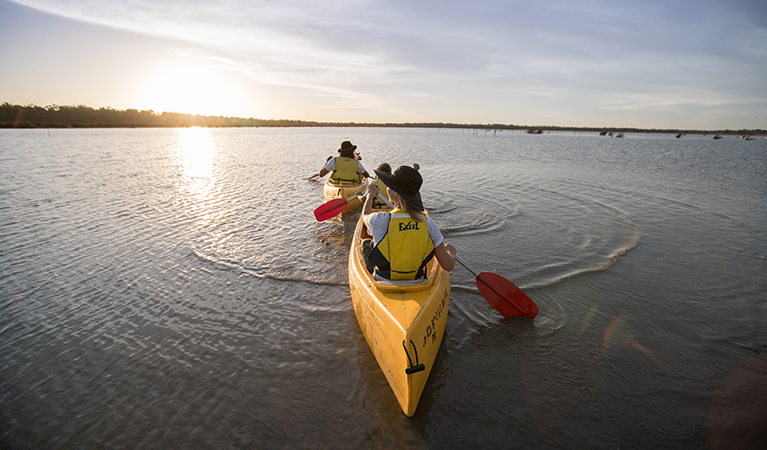Murray River canoe trails
Murray Valley National Park
Overview
These 4 canoe trails in Murray Valley National Park and Victoria’s Barmah National Park offer something for every paddler. Canoe the flowing Murray River, secluded creeks or Barmah Lake.
- When
- September to April is the best time for paddling on the Murray River.
- Accessibility
- Hard
- Distance
- 2.7 to 17.4km of trails
- Grade
- Easy. Suitable for adults and children 10 years and over. All participants must be able to swim. Medium level of fitness required. No experience needed.
- Trip Intention Form
-
It's a good idea to let someone know where you're going. Fill in a trip intention form to send important details about your trip to your emergency contact.
- Please note
- Paddle down the Murray following these maps: Picnic Point to Barmah Lakes day visitor area (664.3KB pdf); Barmah Lakes day visitor area to Rices Bridge and Barmah Lake loops (523.7KB pdf); Barmah Lakes day visitor area to Barmah (629.9KB pdf). Or download the NPWS app to use GPS-enabled maps.
- These activities are graded Grade I river (Easy)
- It’s a good idea to check Murray River water levels and flow rates before you set out. These can affect the safety of paddling and your paddling time.
- The Murray River is safe and best to paddle when water levels are between 1.4m-2.4m; the river becomes too shallow below 1.2m; water levels above 2.7m are considered dangerous.
- Barmah Lake is safe and best to paddle when water levels are between 2.2m-2.8m; the lake becomes too shallow below 1.9m; water levels above 3m are considered dangerous.
- You’ll need to BYO canoe or kayak. Hire and shuttle services are also available – go to Visit the Murray for more information.
All 4 canoe trails in Murray Valley National Park and Barmah National Park have easy water access:
Picnic Point to Barmah Lakes day visitor area (17.4km, one-way, 3hr 30min)
Push off from Picnic Point and follow the mighty Murray downstream through the mouth of Barmah Lake. Stop by Swifts campground for a picnic.
Barmah Lakes day visitor area to Rices Bridge (2.74km, return, 30min)
Paddle downstream to explore Broken Creek and Rices Bridge, before returning the same way.
Barmah Lakes day visitor area to Barmah Lake (5.3km, loop, 1hr 20min)
Head upstream into Barmah Lake for a short loop. A longer loop leads to the lake’s upper reaches, thick with reeds.
Barmah Lakes day visitor area to Barmah (11.08km, one-way, 2hr 15min)
Feel the breeze on your face as you canoe downstream to the town of Barmah.
Enjoy the gentle splash of oars and creak of river red gum branches as you explore the mighty Murray River by paddle power. These Ramsar-listed wetlands are a haven for waterbirds and great for fishing.
Map
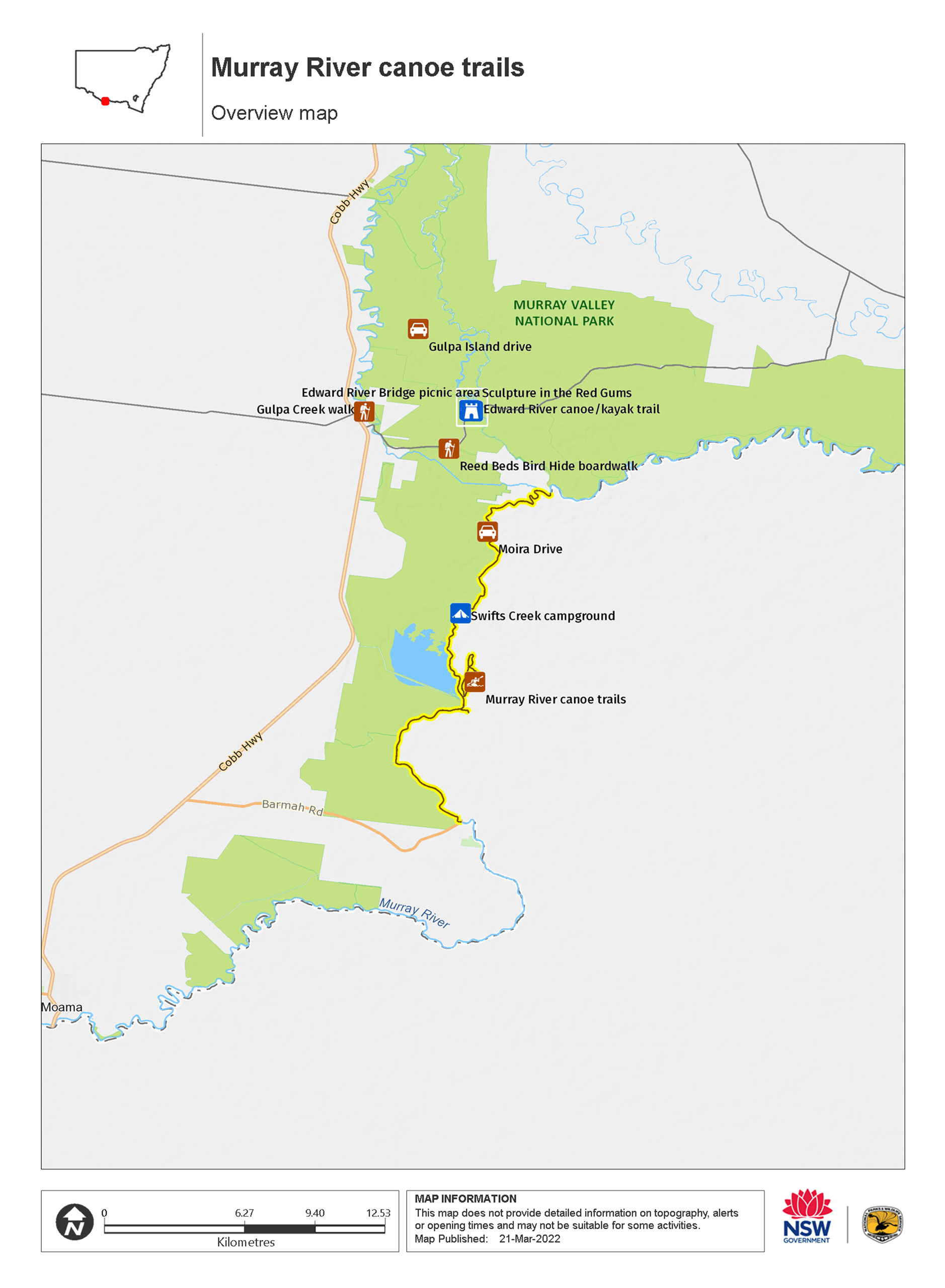
Map legend

Local alerts
For the latest updates on fires, closures and other alerts in this area, see https://www.nationalparks.nsw.gov.au/things-to-do/canoeing-paddling-experiences/murray-river-canoe-trails/local-alerts
Park info
- in Murray Valley National Park in the Murray-Riverina region
Murray Valley National Park is always open but may have to close at times due to poor weather or fire danger.
Visitor info
All the practical information you need to know about Murray River canoe trails.
Getting there and parking
Murray River canoe trails start from Picnic Point in Murray Valley National Park, NSW, or from Barmah Lakes day visitor area or Barmah Punt in Victoria’s Barmah National Park.
To get to Picnic Point:
- From Mathoura, head east along Jones Street
- Follow Jones Street as it becomes Picnic Point Road for approximately 10km to Picnic Point boat ramp.
To get to Barmah Lakes day visitor area, from Moama via Cobb Highway:
- Take the Barmah Road turn-off 14.5km north of Moama
- Turn left at Moira Lakes Road in Barmah
- From Barmah, travel north along Moira Lakes Road for 6.3km
- Turn left into Barmah Lakes day visitor area.
To get to Barmah Punt:
- From Moama, head north along Cobb Highway
- Turn right onto Barmah Road and continue for approximately 14km to Barmah township
- Turn right onto Evans Street to get to Barmah Punt carpark.
Road quality
- Unsealed roads
Vehicle access
- 2WD vehicles
Weather restrictions
- All weather
Parking
Free parking is available at all these locations.
Best times to visit
September to April is the best time for paddling on the Murray River.
Facilities
- Picnic Point: Barbecue, fish cleaning table, general store, toilets, carpark, boat ramp and pontoon.
- Barmah Lakes day visitor area: Picnic shelter, picnic tables, toilets, carparks, boat ramp and information shelter.
- Barmah Punt: General Store, toilet, carpark and boat ramp.
Maps and downloads
Accessibility
Disability access level - hard
Not wheelchair-accessible.
Permitted
Fishing
A current NSW recreational fishing licence is required when fishing in all waters.
Learn more
Murray River canoe trails is in Murray Valley National Park. Here are just some of the reasons why this park is special:
Aboriginal heritage
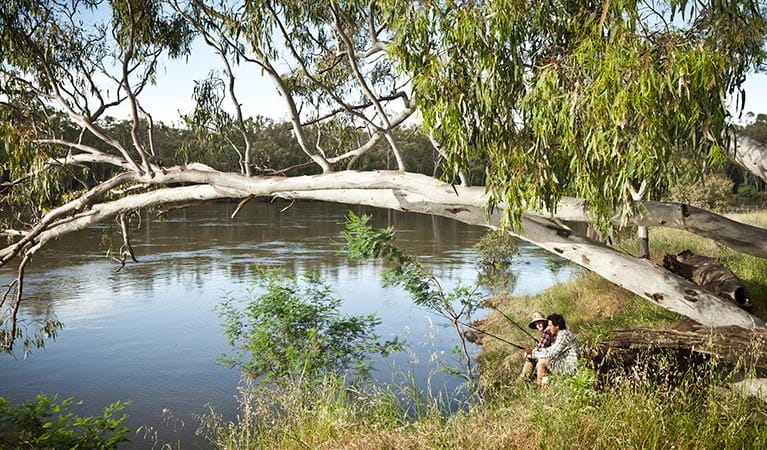
The river red gum forests of the Murray Valley are the traditional Country for Aboriginal people. The landscape and all that it contains; rivers, forests, birds and animals are part of cultural beliefs and feature in Dreaming stories. The park provided a wealth of resources, including plants that were used as medicines and in tool making. The river was a rich food source; in some seasons the water was so clear and the fish plentiful. When you're exploring the park, keep your eyes open for Aboriginal sites, especially middens, oven mounds and scarred trees, where bark has been removed from the tree to make canoes, coolamons and shields.
An abundance of treasures
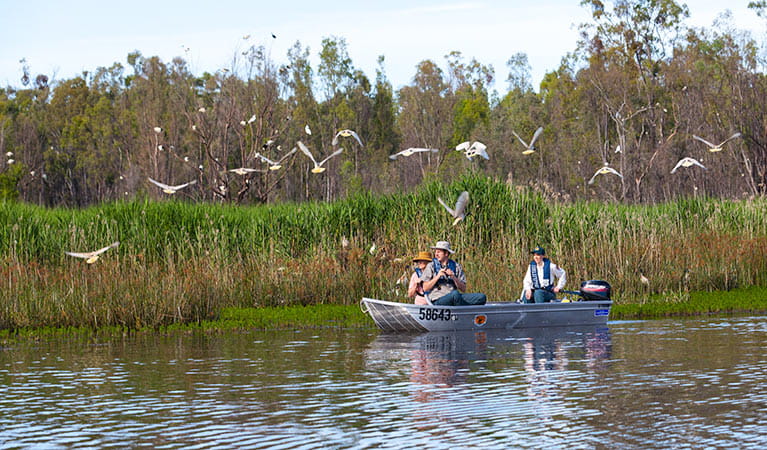
The Ramsar-listed Murray Valley wetland is home to over 60 threatened native animal species and 40 threatened plant species. Lay down the paddle of your canoe and sit in the silence, enjoying the company of egrets and cormorants, and keep an eye out for the superb parrot, slender and bright green. You may also see night herons, black swans, yellow rosellas, ducks, falcons, cockatoos, tree creepers, pardalotes, kingfishers and owls - this is truly a bird-lover's paradise.
- Moira Drive The scenic Moira drive takes you through the gorgeous river red gum forest around the mighty Murray River. Walk to the water bird observatory and stop for a picnic lunch.
- Murray River canoe trails These 4 canoe trails in Murray Valley National Park and Victoria’s Barmah National Park offer something for every paddler. Canoe the flowing Murray River, secluded creeks or Barmah Lake.
- Personalised birding tours around Deniliquin Keen birders will love these tailored outings by Australian Ornithological Services. They're a great way see rare and endemic birds, including plains wanderers, in the unique ecosystems near the outback town of Deniliquin.
- Reed Beds Bird Hide boardwalk It’s an easy walk along the boardwalk to Reed Beds Bird Hide, with fun things to do along the way. Listen to see how many different bird calls you can hear on the way.
Forestry history
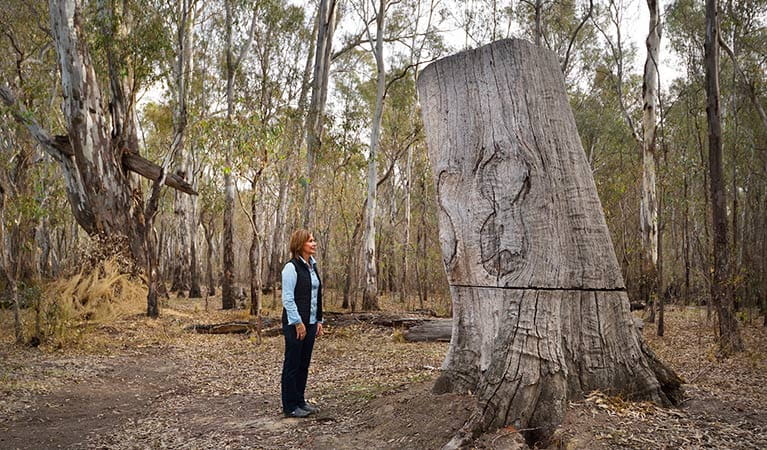
The magnificent river red gums have made this an important area for forestry and milling since the mid-nineteenth century. By the 1870's, construction of railway lines brought great demand for red gum sleepers; logging became a key feature of this area's industry. Wood-chopping events have long been a feature of local festivals and many people who live in Mathoura are third and fourth-generation timber workers.
River red gum country
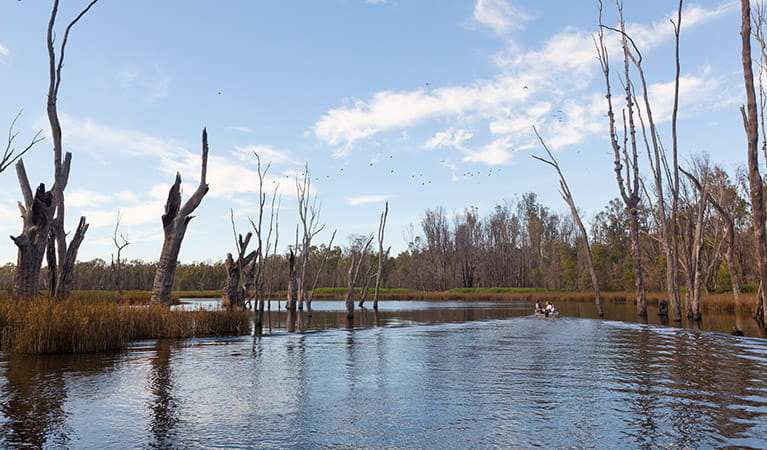
This iconic landscape features the huge river red gums soaring from the banks of the Murray and wetlands that make up this part of the Riverina's important ecosystem. This new park, formed from a number of former state forests, is part of the largest continuous river red gum forest in the southern hemisphere and is an important and unique ecosystem.
- Moira Drive The scenic Moira drive takes you through the gorgeous river red gum forest around the mighty Murray River. Walk to the water bird observatory and stop for a picnic lunch.
- Personalised birding tours around Deniliquin Keen birders will love these tailored outings by Australian Ornithological Services. They're a great way see rare and endemic birds, including plains wanderers, in the unique ecosystems near the outback town of Deniliquin.
Plants and animals protected in this park
Animals
-
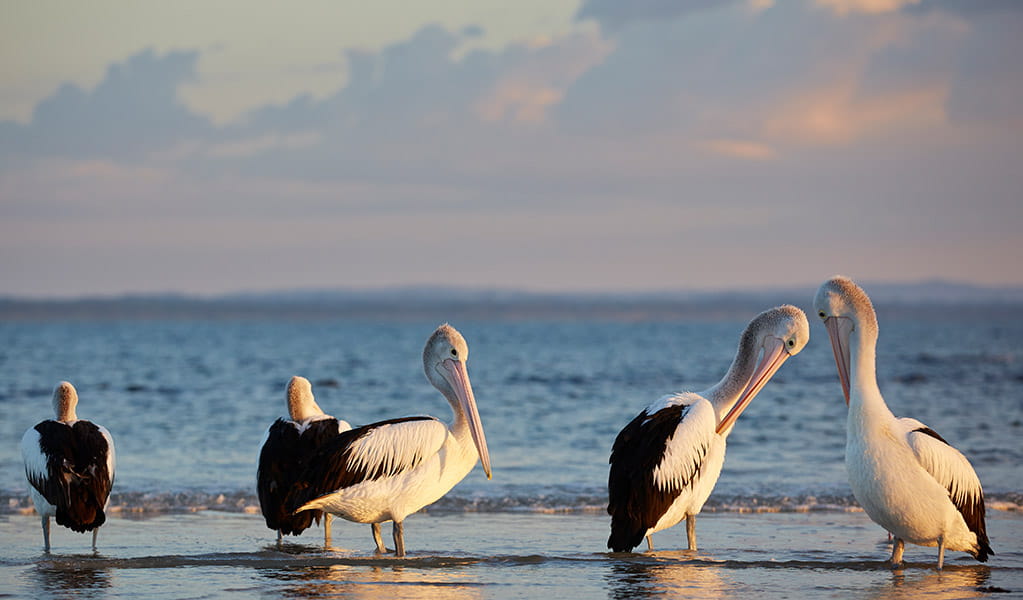
Australian pelican (Pelecanus conspicillatus)
The curious pelican is Australia’s largest flying bird and has the longest bill of any bird in the world. These Australian birds are found throughout Australian waterways and the pelican uses its throat pouch to trawl for fish. Pelicans breed all year round, congregating in large colonies on secluded beaches and islands.
-
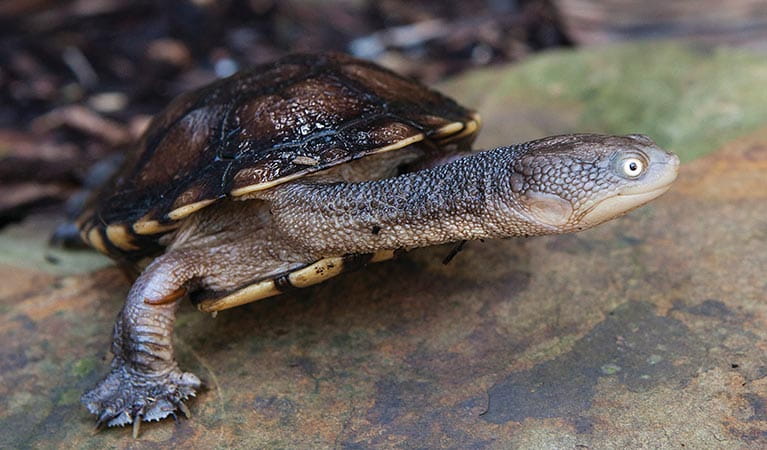
Eastern snake-necked turtle (Chelodina longicollis)
Found across most of NSW, the eastern snake-necked turtle, also known as the eastern long-necked turtle, can be found in swamps, lakes and inland waterways. This freshwater turtle is carnivorous and lives most of its life submerged on the water’s edge, searching for worms and snails.
-
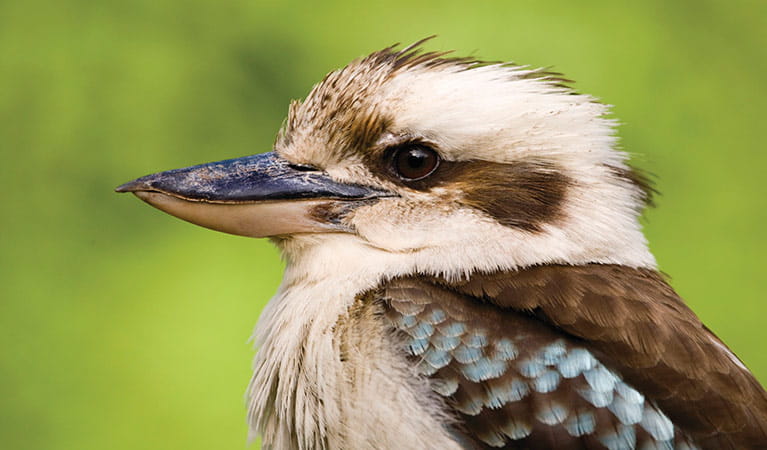
Kookaburra (Dacelo novaeguineae)
Of the 2 species of kookaburra found in Australia, the laughing kookaburra is the best-known and the largest of the native kingfishers. With its distinctive riotous call, the laughing kookaburra is commonly heard in open woodlands and forests throughout NSW national parks, making these ideal spots for bird watching.
-
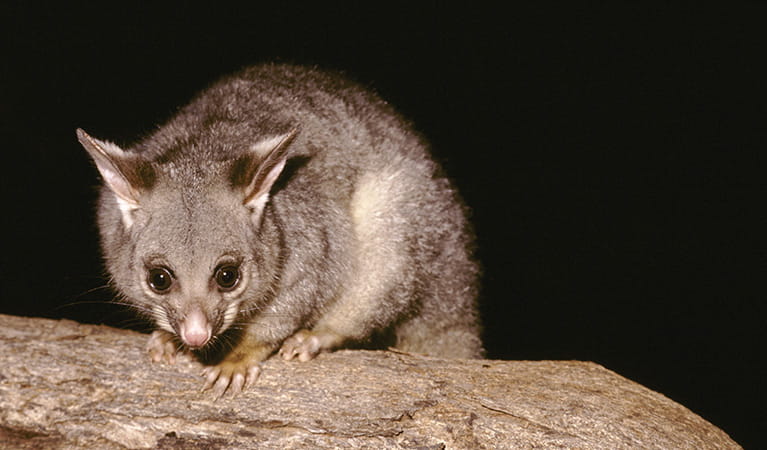
Common brushtail possum (Trichosurus vulpecula)
One of the most widespread of Australian tree-dwelling marsupials, the common brushtail possum is found across most of NSW in woodlands, rainforests and urban areas. With strong claws, a prehensile tail and opposable digits, these native Australian animals are well-adapted for life amongst the trees.
Plants
-
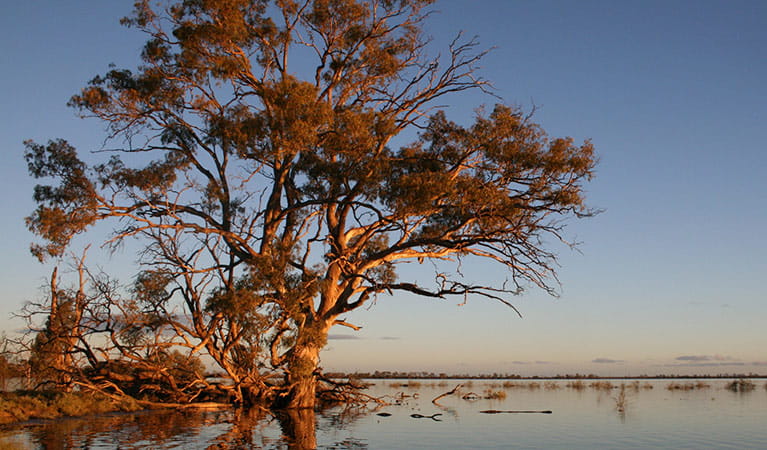
River red gum (Eucalpytus camaldulensis)
Australian native plants, majestic river red gum trees are widespread across Australian inland river systems. The river red gum is a dominant tree species of the Murray-Darling basin which spans NSW, Queensland and Victoria. This iconic native eucalypt grows to a height of 30m and is thought to have a lifespan up to 500-1000 years.

